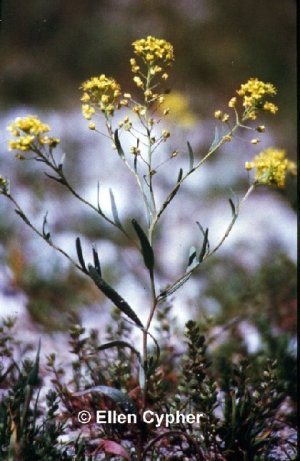Endangered Species Recovery Program | |
|
Home | News | Publications | Species profiles | Data and maps | About | Staff | Links | Department of Biological Sciences | CSU Stanislaus |

Jared's peppergrass
Lepidium jaredii
Status
None federal or state. California Native Plant Society List 1B.
Life History
Both subspecies of Jared's peppergrass are annuals, but few plants bloom in dry years. Panoche peppergrass (L. jaredii ssp. album) flowers from February to June and Carrizo peppergrass (L. jaredii ssp. jaredii) from March to May. Both subspecies can grow in heavy clay or sandy soils. Panoche peppergrass occurs in dry stream beds, on alluvial fans, and on slopes. It is associated with a variety of grasses and forbs as well as the shrubs common saltbush (Atriplex polycarpa), quailbush (Atriplex lentiformis), mulefat (Baccharis salicifolia), and scale-broom (Lepidospartum squamatum). Carrizo peppergrass occurs in association with spiny saltbush (Atriplex spinifera), Munz's tidy-tips (Layia munzii) [CL], and Lost Hills saltbush (Atriplex vallicola) [CL] in low-lying, alkaline areas and with hillside daisy (Monolopia lanceolata) on steep, south-facing slopes. Both subspecies occur at sites below 1,000 m in elevation.
Jared's peppergrass has narrow leaves, which occasionally have a few teeth on the margins. Each plant has many small, four-petaled flowers, which are distributed along the upper portions of each branch. Flower color and plant form differ between the two subspecies: Panoche peppergrass has white flowers and numerous branches, whereas Carrizo peppergrass has yellow flowers and few branches. The flattened, egg-shaped fruits contain two seeds each.
Distribution
Jared's peppergrass ranges from San Benito County south to San Luis Obispo County. Locations mentioned in the literature prior to 1966 can be assigned to a subspecies only tentatively. Apparently, collections from Fresno County and San Benito County represent Panoche peppergrass. Carrizo peppergrass was reported historically from San Luis Obispo County. Populations of Panoche peppergrass have been subject to disturbance from sand and gravel quarrying. Currently, Panoche peppergrass is known or presumed to be extant at approximately 15 occurrences. The majority of the sites are in the Ciervo-Panoche region of Fresno and San Benito counties. One or two sites may remain in southern Fresno County and another in the Orchard Peak area of San Luis Obispo County. Carrizo peppergrass does not seem to have declined. It is extant at several occurrences in San Luis Obispo County, including those south of Soda Lake on the Carrizo Plain and in the eastern foothills of the Caliente Mountains, as well as the Devil's Den area of Kern County.
Classification
Subclass DILLENIIDAE, Order CAPPARALES, Family BRASSICACEAE, Genus Lepidium, Species jaredii
Subspecies
Jared's peppergrass comprises two subspecies, both of which are rare: Panoche peppergrass (L. jaredii ssp. album) and Carrizo peppergrass (L. jaredii ssp. jaredii).
Recent Synonyms
None.
Other Common Names
None.
References
Skinner, M.W., and B.M. Pavlik, eds. 1994. Inventory of rare and endangered vascular plants of California. Fifth edition. Spec. Publ. No. 1, California Native Plant Society, Sacramento, 338 pp.; Hoover, R.F. 1970. The vascular plants of San Luis Obispo County, California. University of California Press, Berkeley, 350 pp.; Hoover, R.F. 1966. Miscellaneous new names for California plants. Leaflets of Western Botany 10:337-350; Hoover, R.F. 1937. Endemism in the flora of the Great Valley of California. Ph.D. Dissertation, University of California, Berkeley, 76 pp.; Twisselmann, E.C. 1956. A flora of the Temblor Range and the neighboring part of the San Joaquin Valley. Wasmann Journal of Biology 14:161-300; Rollins, R.C. 1993. Brassicaceae. Pp. 392-448 in The Jepson manual: higher plants of California (J.C. Hickman, ed.). University of California Press, Berkeley, 1400 pp.; Rarefind, California Natural Diversity Data Base, Sacramento.
Size
Height:
10-70 cm
Flower:
3 mm
Fruit:
3-4 mm
Identification
Jared's peppergrass differs from other Lepidium species in that the leaf bases do not surround the stem, the fruits are not winged, and the style (part of the female reproductive system) protrudes from the tip of the fruit.
Authors of Profile
E.A. Cypher